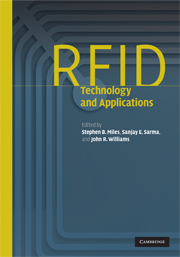Book contents
- Frontmatter
- Contents
- List of contributors
- Preface
- Acknowledgments
- 1 Introduction to RFID history and markets
- 2 RFID technology and its applications
- 3 RFID tag performance optimization: a chip perspective
- 4 Resolution and integration of HF and UHF
- 5 Integrating sensors and actuators into RFID tags
- 6 Performance evaluation of WiFi RFID localization technologies
- 7 Modeling supply chain network traffic
- 8 Deployment considerations for active RFID systems
- 9 RFID in the retail supply chain: issues and opportunities
- 10 Reducing barriers to ID system adoption in the aerospace industry: the aerospace ID technologies program
- 11 The cold chain
- 12 The application of RFID as anti-counterfeiting technique: issues and opportunities
- 13 Closing product information loops with product-embedded information devices: RFID technology and applications, models and metrics
- 14 Moving from RFID to autonomous cooperating logistic processes
- 15 Conclusions
- Appendix – links to RFID technology and applications resources
- Editor biographies
- Index
- References
5 - Integrating sensors and actuators into RFID tags
Published online by Cambridge University Press: 02 November 2009
- Frontmatter
- Contents
- List of contributors
- Preface
- Acknowledgments
- 1 Introduction to RFID history and markets
- 2 RFID technology and its applications
- 3 RFID tag performance optimization: a chip perspective
- 4 Resolution and integration of HF and UHF
- 5 Integrating sensors and actuators into RFID tags
- 6 Performance evaluation of WiFi RFID localization technologies
- 7 Modeling supply chain network traffic
- 8 Deployment considerations for active RFID systems
- 9 RFID in the retail supply chain: issues and opportunities
- 10 Reducing barriers to ID system adoption in the aerospace industry: the aerospace ID technologies program
- 11 The cold chain
- 12 The application of RFID as anti-counterfeiting technique: issues and opportunities
- 13 Closing product information loops with product-embedded information devices: RFID technology and applications, models and metrics
- 14 Moving from RFID to autonomous cooperating logistic processes
- 15 Conclusions
- Appendix – links to RFID technology and applications resources
- Editor biographies
- Index
- References
Summary
Introduction
As applications of RFID tags and systems expand, there is an increasing need to integrate sensors into RFID tags. The RFID tags being used at present in the supply chain indicate what a product is, but do not reveal any information about conditions that the product has encountered throughout its passage along the supply chain. Only a few RFID tags with sensors are commercially available and they are custom-designed tag–sensor combinations. Adding sensors that can measure environmental conditions such as temperature, vibration, chemicals, gases, and health, and the capability to interrogate the sensor outputs, can provide much needed information about the current and historical conditions of the product. The ability to incorporate sensors and possibly actuators into RFID tags would also open a whole new world of imaginable applications in homeland defense, military operations, manufacturing, animal health, medical operations, and other applications. The IEEE (Institute of Electrical and Electronics Engineers) 1451 suite of standards [1–9] was developed to provide for “smart” transducers (sensors and actuators) and flexible network interfaces that facilitate “plug-and-play” capabilities for the transducers. The objective of this chapter is to present the current situation in RFID systems and networked transducers and to describe the strategy that is being adopted and research that will be necessary in order to incorporate “smart” sensors and actuators into existing RFID tags and systems using the IEEE 1451 suite of standards approach.
- Type
- Chapter
- Information
- RFID Technology and Applications , pp. 61 - 73Publisher: Cambridge University PressPrint publication year: 2008
References
- 2
- Cited by



